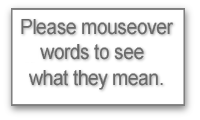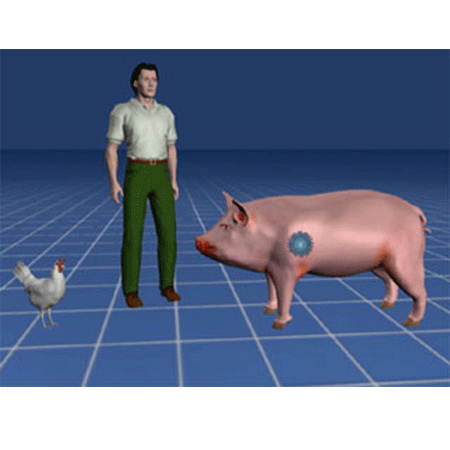Science news in brief
3-May-2009
The week in Real Science

The research below, chosen from hundreds of papers published this week, ranges from swine flu and brain music to invisibility cloaks. Take a look:
24 Apr 2009 Brain music
Every brain has a soundtrack. Tempo and tone vary depending on mood, frame of mind and other features of the brain. When the soundtrack is recorded and played back to an emergency responder or a firefighter it may sharpen their reflexes during a crisis and calm their nerves afterward.
27 Apr 2009 New human movement model for study of epidemics
Researchers have developed a new statistical model that simulates human mobility patterns. It mimics the way people move over the course of a day or a month. The model is the first to represent the regular movement patterns of humans using statistical data. It has a host of potential uses ranging from land-use planning to studies of epidemic disease.
28 April 2009 Top of the class
Who are the students that meet the highest standards in science? What families and communities are they from? What kind of schools do they go to? How are they taught? Do they have science-related activities outside of school? What drives them to study science? What are their attitudes to science and their career intentions?
30 April 2009 Origins from African genetics
African, American and European researchers have released the largest ever study of African genetic data—more than four million genotypes. The research lasted 10 years. It now provides a vast storehouse of information on the continent where modern humans had their origins. It demonstrates startling diversity but shared ancestry among geographically diverse groups. It traces the origins of Africans and African-Americans.

27 Apr 2009 How macrophages kill bacteria
For decades microbiologists believed that the immune cells called macrophages engulf and kill bacteria by damaging their DNA. A new study disproves this. The most potent poisons - reactive oxygen species - are aimed at targets outside the cytoplasm.
28 April 2009 Swine flu: individual responsibility
WHO raised its pandemic alert level yesterday from phase 3 to phase 4 after human cases of a novel H1N1 swine influenza A virus spread quickly around the world from its origin in Mexico. The virus is a hybrid of human, pig, and avian influenza. As of April 28, according to WHO, Mexico had 26 laboratory confirmed human cases of swine influenza A (H1N1) with seven confirmed deaths. The USA had 40 confirmed cases with no deaths. Elsewhere, there were confirmed cases in Canada, UK, Spain, New Zealand, and Israel.
28 April 2009 Strong match between molecular and fossil data
During a seminar several years ago, University of Chicago palaeontologist David Jablonski fielded a hostile question: Why bother classifying organisms according to their physical appearance, let alone analyse their evolutionary dynamics, when molecular techniques had already invalidated that approach? The questioner was wrong, we now know.
1 May 2009 Invisibility cloak - magic or science?
Arthur C. Clarke famously noted the similarities between advanced technology and magic. This summer on the big screen, Harry Potter will again don his magic invisibility cloak and disappear. Meanwhile Berkeley researchers study real invisibility cloaks.
Education resources, classroom activities, cool stuff
Swine flu
Influenza from World Health Organisation
Pandemic alert and response
Is swine flu a bioterrorist virus? New Scientist
Paul Ewald: Infectious disease and the evolution of virulence
Can we domesticate germs video
Bill Sloan: Water treatment plants for the developing world
Transcript of 3 May 2009 podcast
Can I eat pork?
Hello again and welcome to the Real Science review of the week. I should tell you right away that I don't have swine flu – and even if I did you couldn't catch it from listening to this podcast.
Now you knew that already, of course, but tuning in to the twittering out there shows that you and I are in the minority, and a lot of people have no idea how flu spreads.
Mexican pig producers have been badly hit as people worry they might catch the disease by eating pork. Now as a vegetarian I'm all for people not eating pork. But I'm also for rational behaviour and this looked irrational to me. At first.
Then I started wondering. The usual way to catch influenza is through the air, by breathing droplets infected with the virus from other people's sneezes or coughs. It can also get into your nose, throat and lungs, which is where it likes to live, from surfaces such door handles, where it can live for a short time, via your fingers when you touch your nose, mouth or eyes.
So stay away from sneezing people is the message, and don't touch your face with your hands if you've been out, until you've washed any viruses off them.
Sez who?
But who says a flu virus can't get into your body through your stomach? Well the World Health Organisation (WHO) for one, which in response to the question "Is it safe to eat pork?" confidently replies:
"Yes."
It then continues: "Swine influenza has not been shown to be transmissible to people through eating properly handled and prepared pork."
On reading which the scientist in me goes "Hang on a minute, boys."
Because "has not been shown to" is not the same as "has been shown not to". Not by a long way. Same words. Slightly different order. Totally different meaning. Totally.
"Has not been shown to be transmissible" almost certainly means no one has done any experiments to test the idea. Or if they have they didn't find anything. But there could be any number of reasons for that – like the experiment was badly designed or not sensitive enough.
"Has been shown not to be transmissible" is a very strong statement that would need a whole lot of work, ingenuity and evidence to be able to make with certainty.
Playing safe
All of which illustrates the difference between politicians and public health people on the one hand and scientists on the other. Public health statements need to be both clear and clear-cut. Science is full of uncertainties, hypotheses, probabilities and statistical significance. So you probably don't want a scientist to tell people about public health issues. But you do want to be a scientist when you're thinking about what people are telling you about these issues.
That "properly handled and prepared" is worrying to someone thinking like a scientist, for instance, since it raises the possibility that you might catch the virus by eating improperly handled pork.
So I now believe I was wrong to dismiss the twitterers' attitude to eating Mexican pork as irrational. They're playing safe with their health, not taking the official line and erring on the side of caution. And given the poor quality of official lines on many issues in recent years, from Iraq to mad cows, what's wrong with that?
Flu science
Having got that out of the way I started to think about the science of flu. As I've said in a previous post a good way into the real science of any story is to ask yourself what you don't understand. When I did that with influenza something jumped out at me.
Flu viruses – indeed all viruses – are parasites. They need a host to survive and reproduce. So what on earth is a parasite doing killing its host, as flu regularly does to a small – and in pandemic flu often a larger – fraction of its victims?
A virus works by getting into your body cells and hijacking their machinery to produce huge numbers of copies of itself. But if in doing that it immediately kills the host those cells belong to, the virus has got itself into a dead end. Literally. All those new copies will soon be dead. If that virus's ancestors had behaved in that way the virus wouldn't be around today. So where do killer viruses get their lethal behaviour from?
Domestos or domestic?
Once you start asking these kind of questions the next step in science is to see who else has been asking the same questions, and what answers they've come up with. That soon led me to the work of Paul Ewald, which we link to in the resources section.
Ewald's point is that the deadliness of a microbe depends on its lifestyle, and in particular on how it gets from one host to another. The common cold needs people up and about and mixing with other people to get itself spread, while malaria can infect others just as well, if not better, when its sufferers are flat on their backs and sitting-ducks for the mosquitoes that carry the disease.
Water-borne illnesses like cholera are especially deadly in places with poor sanitation, Ewald points out, because although the sufferer might be unable to move, someone washes their soiled sheets and clothes, which releases the bacteria into the water supply to infect others.
Ewald's big idea is that we can domesticate disease-causing viruses and bacteria, by making sure that methods of getting from one person to another that work even when the sufferer is too ill to move are cut off. Strains of the organism that cause mild illness will then outcompete the strains that cause serious illness and death.
In this way we get evolution working for us instead of against us as it does now, when we tackle diseases head-on and set up arms-races, in which stronger antibiotics create more resistant microbes which need stronger antibiotics and so on – all of which leads in the end to diseases such as tuberculosis that were once thought defeated returning to kill large numbers of people.
Search sketch
We'll talk about Ewald, evolution and disease in future posts. In the time remaining now though I want to briefly sketch the search procedure that homes in on science that answers a particular question – because there are a couple of useful ideas there that are not widely known in schools.
Go back to the stage where we were trying to get at the science in a story by asking what it is we don't understand. What we're looking for in the next stage is a word or phrase that homes in on the ideas that's puzzling us.
So I tried searching on virus evolution first, using the Real Science Find More page – which searches a set of sites I know are good for science and education.
That came up trumps with the Evolution from a virus's view page at Berkeley – which we link to in our resources section. How does that help us? Well there's a lot of useful information on that page that goes a long way to answering our question. But there's more than that. In the second line is the word we're looking for that lets us home in on exactly what's puzzling us.
All in a word
That word is virulent.
It's a word that comes from the same Latin word – meaning full of poison – as virus itself, but it also applies to bacteria. Virulence is about how ill you get. A very virulent disease – or virus or bacterium – makes you very ill and can kill you. A less virulent disease makes you less ill. Virulence is a measure of how bad the disease is.
Searching on virulence or virulent gives us lots of fascinating science about why viruses kill and how we can stop them – including Paul Ewald's work in words, images and video.
One final question I had when listening to all the news about swine flu. What's a pandemic and how's it different from an epidemic?
Well pan comes from the Greek word for all whereas epi is an all-purpose preposition that can mean above, over, on, toward, among. The second part of both words comes from the Greek demos meaning people.
So an epidemic is an outbreak of disease among the people in a place or region. A pandemic is an epidemic that goes global. It might or might not be virulent. As of today – 2 May 2009 – swine flu looks like it could become a pandemic but not a virulent one, although that could change quickly if the virus mutates.
That's all for this week from Real Science.
Thanks for listening.
Keep thinking.
And keep washing your hands.
More help with words
complex, molecule, DNA, protein, tentative, prediction, experiment, rational, infectious, sewage, species, individual, breed, fertile, gene, inherit, conception, fertilisation



